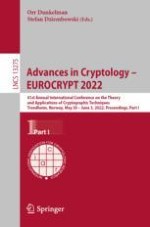2022 | OriginalPaper | Chapter
Asymptotically Quasi-Optimal Cryptography
Authors : Leo de Castro, Carmit Hazay, Yuval Ishai, Vinod Vaikuntanathan, Muthu Venkitasubramaniam
Published in: Advances in Cryptology – EUROCRYPT 2022
Publisher: Springer International Publishing
Activate our intelligent search to find suitable subject content or patents.
Select sections of text to find matching patents with Artificial Intelligence. powered by
Select sections of text to find additional relevant content using AI-assisted search. powered by
